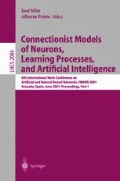Abstract
In 1992 neurophysiologists [20] found a new type of cells in areas V1 and V2 of the monkey primary visual cortex, which they called grating cells. These cells respond vigorously to a grating pattern of appropriate orientation and periodicity. Three years later a computational model inspired by these findings was published [9]. The study of this paper is to create a grating cell operator that has similar response profiles as monkey grating cells have. Three different databases containing a total of 338 real world images of textures are applied to the new operator to get better a insight to which natural patterns grating cells respond. Based on these images, our findings are that grating cells respond best to repetitive alternating patterns of a specific orientation. These patterns are in common human made structures, like buildings, fabrics, and tiles.
Access this chapter
Tax calculation will be finalised at checkout
Purchases are for personal use only
Preview
Unable to display preview. Download preview PDF.
References
D. G. Albrecht, R. L. de Valois, and L. G. Thorell. Visual cortical neurons: are bars or gratings the optimal stimuli? Science, 207:88–90, 1980.
B. W. Andrews and D. A. Pollen. Relationship between spatial frequency selectivity and receptive field profile of simple cells. J. Physiol., 287:163–176, 1979.
John G. Daugman. Uncertainty relation for resolution in space, spatial frequency, and orientation optimized by two-dimensional visual cortical filters. J. Opt. Soc. Amer., 2(7):1160–1169, 1985.
K. R. Gegenfurther, D. C. Kiper, and S. B. Fenstemaker. Processing of color, form, and motion in macaque area v2. Visual Neuroscience, 13:161–172, 1996.
D. Hubel and T. Wiesel. Receptive fields, binocular interaction, and functional architecture in the cat’s visual cortex. Journal of Physiology, London, 160:106–154, 1962.
D. H. Hubel and T. N. Wiesel. Sequence regularity and geometry of orientation columns in the monkey striate cortex. J. Comp. Neurol., 154:106–154, 1974.
J. Jones and L. Palmer. An evaluation of the two-dimensional gabor filter model of simple receptive fields in cat striate cortex. Journal of Neurophysiology, 58:1233–1258, 1987.
E. Kaplan and R. M. Shapley. The primate retina contains two types of ganglion cells, with high and low contrast sensitivity. Proc. Natl. Acad. Sci. U.S.A., 83:2755–2757, April 1986.
P. Kruizinga and N. Petkov. A computational model of periodic-pattern-selective cells. In J. Mira and F. Sandoval, editors, Proceedings of the International Workshop on Artificial Neural Networks, IWANN’ 95, volume 930 of Lecture Notes in Computer Science, pages 90–99. Springer-Verlag, June 7-9 1995.
M. S. Livingstone and D. H. Hubel. Anatomy and physiology of a color system in the primate visual cortex. J. Neurosci., 4:309–356, 1984.
T. Lourens. A Biologically Plausible Model for Corner-based Object Recognition from Color Images. Shaker Publishing B.V., Maastricht, The Netherlands, March 1998.
M. C. Morrone and D. C. Burr. Feature detection in human vision: A phasedependent energy model. Proc. of the Royal Society of London, 235:335–354, 1988.
J. A. Movshon, I. D. Thompson, and D. J. Tolhurst. Receptive field organization of complex cells in the cat’s striate cortex. Journal of Physiology, 283:53–77, 1978.
N. Petkov and P. Kruizinga. Computational models of visual neurons specialized in the detection of periodic and aperiodic oriented visual stimuli: bar and grating cells. Biological Cybernetics, 76(2):83–96, 1997.
H. Tamura, H. Sato, N. Katsuyama, Y. Hata, and T. Tsumoto. Less segregated processing of visual information in v2 than in v1 of the monkey visual cortex. Eur. J. Neuroscience, 8:300–309, 1996.
K. K. De Valois, R. L. De Valois, and E. W. Yund. Responses of striate cortical cells ito grating and checkerboard patterns. J. Physiol. (Lond.), 291:483–505, 1979.
R. L. De Valois, D. G. Albrecht, and L. G. Thorell. Cortical cells: bar and edge detectors, or spatial frequency filters. In S. J. Cool and E. L. Smith III, editors, Frontiers of Visual Science, Berlin, Heidelberg, New York, 1978. Springer.
R. von der Heydt. Approaches to visual cortical function. In Reviews of Physiology Biochemistry and Pharmacology, volume 108, pages 69–150. Springer-Verlag, 1987.
Rüdiger von der Heydt, Esther Peterhans, and Max R. Dürsteler. Grating cells in monkey visual cortex: Coding texture? Visual Cortex. In B. Blum, editor, Channels in the visual nervous system: neurophysiology, psychophysics and models, pages 53–73, London, 1991. Freund Publishing House Ltd.
Rüdiger von der Heydt, Esther Peterhans, and Max R. Dürsteler. Periodic-Patternselective Cells in Monkey Visual Cortex. The Journal of Neuroscience, 12(4):1416–1434, April 1992.
R. P. Würtz and T. Lourens. Corner detection in color images through a multiscale combination of end-stopped cortical cells. Image and Vision Computing, 18(6-7):531–541, April 2000.
S. Zeki. A Vision of the Brain. Blackwell science Ltd., London, 1993.
Author information
Authors and Affiliations
Editor information
Editors and Affiliations
Rights and permissions
Copyright information
© 2001 Springer-Verlag Berlin Heidelberg
About this paper
Cite this paper
Lourens, T., Okuno, H.G., Kitano, H. (2001). Detection of Oriented Repetitive Alternating Patterns in color Images. In: Mira, J., Prieto, A. (eds) Connectionist Models of Neurons, Learning Processes, and Artificial Intelligence. IWANN 2001. Lecture Notes in Computer Science, vol 2084. Springer, Berlin, Heidelberg. https://doi.org/10.1007/3-540-45720-8_12
Download citation
DOI: https://doi.org/10.1007/3-540-45720-8_12
Published:
Publisher Name: Springer, Berlin, Heidelberg
Print ISBN: 978-3-540-42235-8
Online ISBN: 978-3-540-45720-6
eBook Packages: Springer Book Archive

